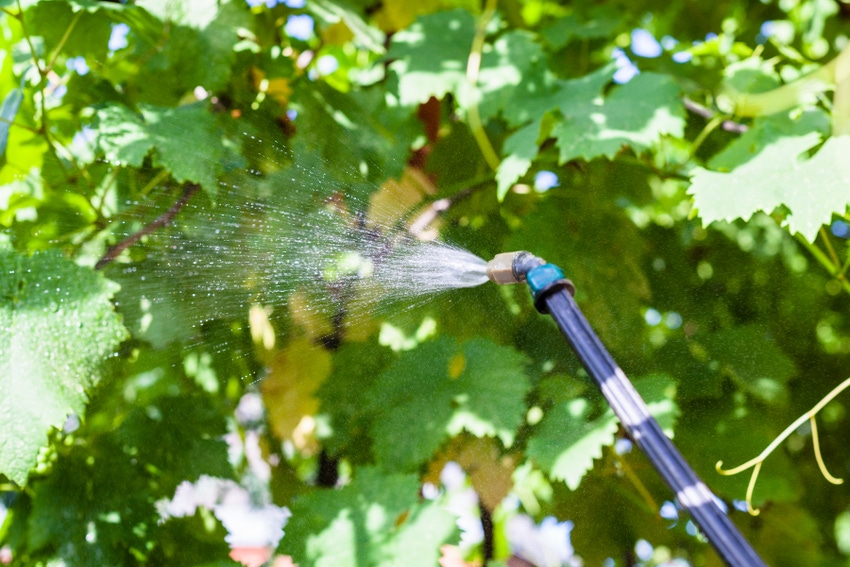
California’s grape growers have a new tool to help them control vine mealybug populations in their vineyards. It comes in the form of a sprayable synthetic sex pheromone designed to disrupt the ability of the insects to mate.
Made by Suterra, CheckMate VMB-F is a liquid formulation of the pheromone used in the company’s CheckMate VMB-XL dispenser-based mating disruption product, which has been available for several years.
Both products are designed to reduce mating success by spreading the volatile chemical throughout the vineyard to mimic the natural sex pheromone emitted by females, making it difficult for males to find and mate with the females.
The vine mealybug is found in all of California’s major grape growing areas. Like other grape-infesting mealybugs it produces honeydew that drops onto the clusters and other vine parts and serves as a substrate for black sooty mold.
Table grape bunches contaminated with mealybugs are unacceptable for export markets and can cause significant losses domestically. In wine grapes, mealybugs are a concern not only because they can contaminate clusters, but they are a vector for grapevine leafroll virus. Mealybugs in raisin grapes can be a major concern due to cluster contamination and because of the lower market value compared to table and wine grapes makes control options less affordable.
CheckMateVMB-F received its label midway through last year’s grape season. During 2016, a small number of growers participated in field trials conducted in Kern County by University of California entomology farm advisor David Haviland.
At a field meeting this spring he reported participating growers were excited about the results they saw and plan on expanding use during the current season. He also looks forward to seeing what happens when the pheromone is applied to large acreages, compared to the 10-acre plots used in his studies.
Grape growers who have used mating disruption in the past are familiar with the CheckMate VMB-XL dispenser product, Haviland notes. It is placed in vineyards at the rate of 250 per acre during the spring. Each dispenser is made of a plastic material impregnated with the volatile pheromone molecules. The product releases the sex attractant throughout the season to spread it around the vineyard.
In the case of the new CheckMate VMB-F product, the gaseous pheromone is enclosed inside microcapsules that come in a liquid formulation that is mixed with water and sprayed onto the vineyard. The product can be sprayed on the vines by itself, or it can be tank-mixed with other crop protectants, such as fungicides and miticides, and sprayed with them.
Haviland likens the action of CheckMate VMB-F to a party balloon, filled with air, which slowly leaks out over several days. In this case, the tiny capsules, invisible to the naked eye, are the balloons, which are filled with the gaseous pheromone. Once sprayed, these capsules remain on the foliage where the pheromone slowly passes out through the capsule membrane and into the air, flooding the environment with pheromone and making it difficult for males to find real females.
Unlike the dispenser-based system, the sprayable form of the pheromone is not approved for organic use. “The pheromone, itself, is organic,” Haviland says. “But, the process used to encapsulate it is not organic. So organic growers using mating disruption will need to use the dispenser product.”
Effective use of CheckMate VMB-F does not require treating every row. Instead, it can be applied in both directions to every other row to save application costs, he notes.
The microcapsules release all the pheromone molecules within about a month after spraying, when they are no longer effective in disrupting mating.
Typically, male vine mealybugs in the Central Valley are found from mid-May through October. This is the window in which sprayable pheromone could be applied to the vineyards, Haviland says.
“Depending on the grape variety, harvest date, the number of vine mealybugs in the vineyard and the tolerance for the insects at harvest, the product could be applied just once or as many as five times during the season,” he said. “Checkmate VMB-F can also give you a jump start on treating a new infestation. For example, if you’ve recently found a new VMB infestation, you can make one or more sprays to disrupt mating and help to keep the population lower from the start.”
By contrast, when placed in a vineyard in mid-May, a single CheckMate VMB-XL dispenser remains effective for the rest of the season, Haviland notes.
The price of one application of the sprayable pheromone is about one-fifth the cost of the dispenser system, he reports. That makes the cost of five pheromone sprays for season-long control comparable to the cost of a single pheromone dispenser for the same period of time.
“The sprayable product gives you the flexibility of surgically applying the pheromone when and where you want it, without being committed to the more expensive season-long dispenser system in cases when it isn’t needed or is too expensive,” Haviland says.
He recommends using the sprayable pheromone in conjunction with pheromone traps to track male activity for two reasons: To determine when to apply the first treatment and to assess the effectiveness of the treatment and the need to re-apply the product as the season progresses.
“If you’re catching a lot of male vine mealybugs and then spray the pheromone, you should immediately see a drop in the number of catches,” Haviland explains. “This indicates the pheromone is working to confuse the males, because, if they can’t find traps, they probably aren’t finding females, either. As the effectiveness of the spray treatment declines, the number of trapped males will rebound. That’s when it’s time to determine if another treatment is needed.”
About the Author(s)
You May Also Like




